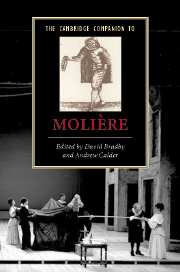Book contents
- Frontmatter
- 1 The career strategy of an actor turned playwright: 'de l’audace, encore de l’audace, toujours de l’audace’
- 2 The material conditions of Molière’s stage
- 3 The master and the mirror: Scaramouche and Molière
- 4 Molière as satirist
- 5 How (and why) not to take Molière too seriously
- 6 L’Avare or Harpagon’s masterclass in comedy
- 7 Laughter and irony in Le Misanthrope
- 8 Comédies-ballets
- 9 Le Bourgeois gentilhomme: Molière and music
- 10 Medicine and entertainment in Le Malade imaginaire
- 11 Molière and the teaching of Frenchness: Les Femmes savantes as a case study
- 12 L'École des femmes: matrimony and the laws of chance
- 13 Molière nationalised: Tartuffe on the British stage from the Restoration to the present day
- 14 Landmark twentieth-century productions of Molière: a transatlantic perspective on Molière: mise en scène and its historiography
- 15 Dom Juan the Directors’ Play
- 16 ‘Reculer pour mieux sauter’: modern experimental theatre’s debt to Molière
- Select bibliography
- Index
- Series List
6 - L’Avare or Harpagon’s masterclass in comedy
Published online by Cambridge University Press: 28 March 2007
- Frontmatter
- 1 The career strategy of an actor turned playwright: 'de l’audace, encore de l’audace, toujours de l’audace’
- 2 The material conditions of Molière’s stage
- 3 The master and the mirror: Scaramouche and Molière
- 4 Molière as satirist
- 5 How (and why) not to take Molière too seriously
- 6 L’Avare or Harpagon’s masterclass in comedy
- 7 Laughter and irony in Le Misanthrope
- 8 Comédies-ballets
- 9 Le Bourgeois gentilhomme: Molière and music
- 10 Medicine and entertainment in Le Malade imaginaire
- 11 Molière and the teaching of Frenchness: Les Femmes savantes as a case study
- 12 L'École des femmes: matrimony and the laws of chance
- 13 Molière nationalised: Tartuffe on the British stage from the Restoration to the present day
- 14 Landmark twentieth-century productions of Molière: a transatlantic perspective on Molière: mise en scène and its historiography
- 15 Dom Juan the Directors’ Play
- 16 ‘Reculer pour mieux sauter’: modern experimental theatre’s debt to Molière
- Select bibliography
- Index
- Series List
Summary
One of the most striking features of L'Avare is the fact that Harpagon bestrides the stage like a colossus, present in twenty-three out of thirty-two scenes, with his dominant presence bearing down even more heavily on the final two acts. At first sight, from a structural point of view, the play seems at best nothing but a series of hastily assembled sketches on avarice, with an inconsequential, meandering plot, at worst simply unbalanced with insufficient counterweight to Harpagon. To many critics, the play ushers into the Molière canon a new disturbing note of bitter cynicism in relationships between the characters. Finally, and most persistently, the familiar accusation of plagiarism levelled against Molière by his contemporaries seems documented to an overwhelming extent. The charge of Riccoboni, to the effect that it would be an achievement to find four scenes of the playwright's own devising, seems self-evident. Yet the view of Molière's friend, the poet Boileau, that L'Avare is one of his best plays, is borne out by its perennial popularity with theatre audiences. This chapter seeks to investigate some of the ways in which Molière's stagecraft enables him to theatricalise an old theme through the creation of a multi-dimensional character of comedy, with appropriate references to sources deemed 'major'.
Whenever Molière's legion of contemporary critics questioned the originality of his plays, usually out of well-grounded reasons of professional jealousy, they arrived at the answer implicit in their question. Looking for originality of theme and plot, they concluded predictably that neither was to be found.
- Type
- Chapter
- Information
- The Cambridge Companion to Moliere , pp. 83 - 94Publisher: Cambridge University PressPrint publication year: 2006



